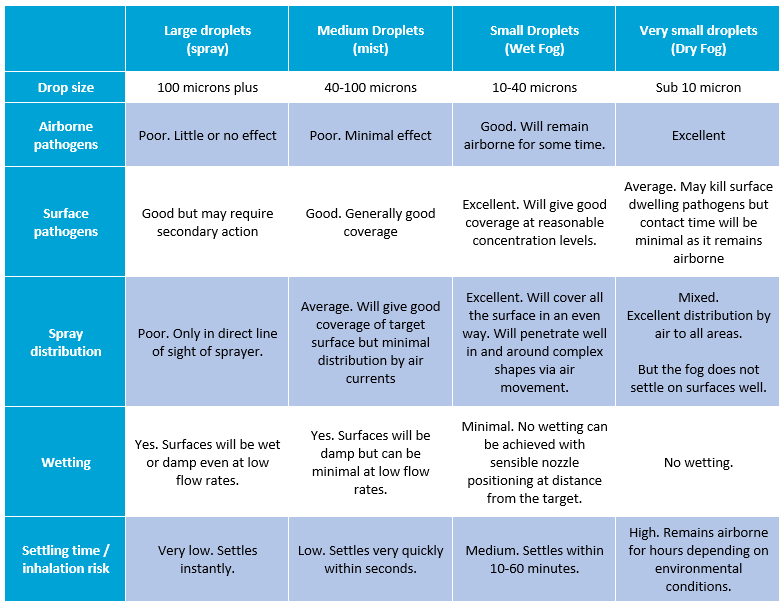Droplet size for disinfection applications
Droplet size can be very important in disinfection applications.
Larger droplet sprays
Sprays with droplets above 100 microns will not aerosolise or drift much. They will remain on target from the nozzle to the target. As many disinfectants can be toxic to humans, especially if inhaled, large droplets may be advantageous in many disinfecting spray systems. If the application requires that the disinfecting liquid remains only on the target surface and there is a health and safety risk posed by inhalation, then large droplet sprays will be ideal.
The disadvantage of larger droplets mean that they will not form even coatings on surfaces so patches may be missed. Also, the surfaces will become wet to the touch and so may require drying. These two disadvantages can be compensated for by secondary wiping/drying applications.
Medium droplets
Fine sprays in the 40-100 micron range will not aerosolise too much and will remain on target as long as there are no lateral air currents to cause drift. These fine sprays will tend to form a far more even coating than larger drop sizes. As such, a secondary wiping application may not be required to ensure all areas of the surface will be contacted.
Sprays within this droplet size range will still cause some dampening of the surface so some drying time will be required before it is no longer wet. With a suitably designed spraying system, however, good coverage with minimal wetting and drying times can be achieved with these types of nozzle.
The disadvantages of using sprays with this droplet size range are that they will only hit targets that are in the direct line of sight of the nozzle. Additional movement and dispersal on air currents is minimal and so complex surfaces that have areas out of line of sight of the nozzles will be missed.
Wet fogs
A wet fog will have droplets within the 10 to 40 micron range. These fogs will remain airborne for some time and will have good movement in any air currents. This means they will be carried around and fill up an area quickly. When the droplets come into contact with a surface they will tend to adhere to the surface and start to form a coating. This makes them ideal for the micro-coating of complex shaped objects or entire rooms.
In addition, the fact that the fog remains airborne for some time means that airborne pathogens will also be targeted.
Despite causing some wetting, this is at a very low level. If a wet fog is suitably distributed over a wide area, then it will not cause surfaces to become damp. Wet foggers may still be suitable for use around electrical equipment depending on how well air is circulated and how well distributed the fog is. A wet fog nozzle pointing directly at a PC at close range will damage it. The same nozzle situated several metres away may not because the fluid has dispersed enough to not present a wetting hazard.
The disadvantage of wet fogs is that they will represent an inhalation hazard whilst they remain airborne. They will tend to settle out of the air within 30 minutes or so (depending on the drop size) and so, unlike dry fogs, do not represent a persistent hazard or require special venting to remove them.
Dry fogs
A dry fog will typically have a droplet size below 10 microns. These fogs are so named because they will not cause wetting to surfaces they come into contact with. Droplets this small tend to move around or bounce off surfaces. As such, they will remain airborne for very long periods of time without settling out. The fog will tend to evaporate long before it can cause any wetting, hence the name “dry” fog.
This means that in a confined area with some air movement the fog will move around and fill the entire space. It will naturally, overtime, become uniformly distributed in the airspace and then remain suspended. What this means is that these fogs are excellent for disinfecting airspaces from airborne pathogens. The increased dwell time in the air and the uniform distribution to all areas maximises the contact between the airborne pathogen and the disinfectant.
The disadvantage of dry fogging systems is that they do not deposit well on surfaces. Pathogens that are on surfaces will only meet the dry fog for fleeting periods of time. If they are shielded from the air by even a very thin layer of grease or grime then they may not come into contact with the disinfectant at all. Dry fogs will work very well for a thoroughly pre-cleaned environment but may be less effective for treating surfaces that may have some dirt on them which serves to shield any pathogens from contact with the disinfectant.
A second potential issue is that because the fog remains airborne for long periods of time the room may be hazardous to enter for extended periods. The extent of this hazard will depend on the disinfectant being used but the inhalation risk of very finely atomised droplets can be significant as they can penetrate deep into the lungs if breathed in. Larger droplets tend not to penetrate deep into the lungs and will settle out of the air quickly meaning this is far less of a hazard for wet fogs or sprays.
